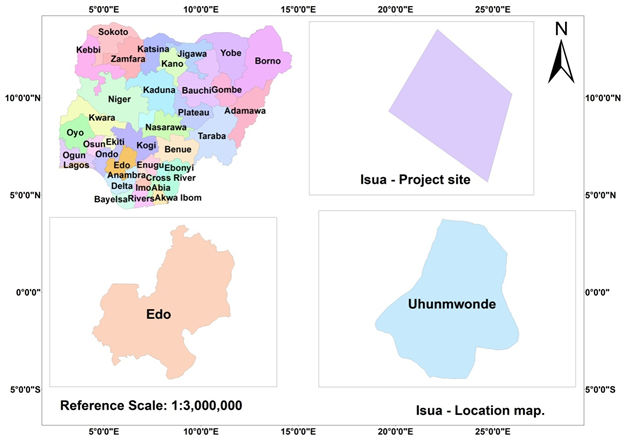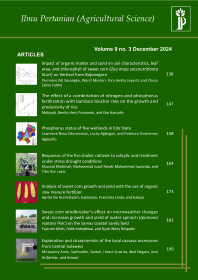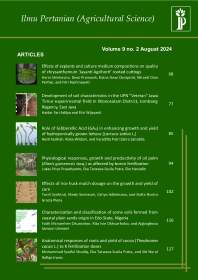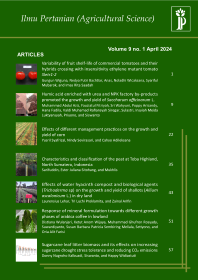
Suitability assessment for oil palm (Elaeis guineensis) and coconut (Cocus nucifera) cultivation in coastal plain sands of South Southern Nigeria
Faith Ehinomhen Okunsebor(1*), Aigboghosa Samson Umweni(2), Lucky Agbogun(3)
(1) Department of Soil Science and Land Management, Faculty of Agriculture, University of Benin P.M.B 1154, Ugbowo Lagos Rd, Benin City, Edo State, Nigeria
(2) Department of Soil Science and Land Management, Faculty of Agriculture, University of Benin P.M.B 1154, Ugbowo Lagos Rd, Benin City, Edo State, Nigeria
(3) Department of Soil Science and Land Management, Faculty of Agriculture, University of Benin P.M.B 1154, Ugbowo Lagos Rd, Benin City, Edo State, Nigeria
(*) Corresponding Author
Abstract
Some soils of coastal plain sands in South Southern Nigeria were assessed for oil palm and coconut cultivation. This research was carried out to evaluate the soils of the study area using rigid grid soil survey methodology at detailed scale. The study area (128.11 ha) was delineated into four soil mapping units based on soil type. A pedon was sunk in each mapping unit and described according to FAO. Three soil orders, including Entisols (Ahiara), Inceptisols (Kulfo) and Ultisols (Orlu), were identified. Parametric and limitation methods of land suitability evaluation were used. Major limitations to assessment were climate (mean annual temperatures) and soil physical properties (texture/structure). Aggregate suitability rating (both actual and potential) showed that Ultisols (pedons 3 and 4, covering 56.73 ha) was moderately suitable (S2) for coconut and marginally suitable (S3) for oil palm, Inceptisols (pedon 2, covering 54.25 ha) was marginally suitable (S3) for coconut but not suitable (NS) for oil palm, and Entisols (Pedon 1covering 17.13 ha) was not suitable (NS) for any of the crops. Thus, area with Entisols should not be used for cultivation of any of the crops due to major limitation in texture. Moreover, both assessment approaches captured the major limitations. Therefore, the use of any of the approaches employed in this study and for these crops becomes a matter of choice as both of them showed no major differences in the application of their procedures.
Keywords
Full Text:
PDFReferences
Addeo, G.G., Guastadisegni, G., and Pisante, M. (2001). Land and water quality for sustainable and precision farming. World Congress on Conservation Agriculture, Madrid, pp.34–38.
Ahukaemere, C.M. (2018). Suitability evaluation of some soils of South-Eastern Nigeria for oil palm (Elaeis guineensis) and cocoa (Theobroma cacao) cultivation. Int’l Journal of Agric. and Rural Dev., 21(1), pp. 3355-3361.
Anderson, J.M. and Ingram, J.S.I. (1993). Tropical soil biology and fertility: a handbook of methods, 2nd ed. Wallingford: CAB International, pp. 221.
Behzad, M., Albaji, M., Papan, P., Nasab, B.S., Naseri, A.A., and Bavi, A. (2009). Qualitative evaluation of land suitability for principal crops in the Gargar Region, Khuzestan Province, Southwest Iran. Asian Journal of Plant Sciences, 8(1), pp. 28-34.
Bremner, J.M. (1996). Nitrogen total. In: Sparks, D.L. ed., Methods of soil analysis. Part 3, Chemical Methods. 2nd ed. Madison: Soil Science Society of America, pp. 1085-1125.
Djaenudin, D., Marwan, H., Subagyo, H., and Hidayat A. Petunjuk teknis evaluasi lahan untuk komoditas pertanian. 1st ed. Bogor: Balai Penelitian Tanah, pp. 132.
Gee, G.W. and Or, D. (2002). Particle size analysis. In: Dane J.H. and Topp, G.C., eds., Methods of Soil Analysis Part 4. Physical Methods. Madison: Soil Science Society of America, pp. 225-293.
Food and Agriculture Organization. (2006). Guidelines for soil description. 4th ed. Rome: AGLS, FAO, pp. 21-65
Food and Agriculture Organization. (1984). Guidelines of land evaluation for rainfed agriculture. Soils Bulletin No. 52. Rome: FAO, pp.191
Food and Agriculture Organization. (1976). A framework for land evaluation. FAO Soils Bulletin 52, 1st ed. Rome: FAO, pp.79.
International Institute for Tropical Agriculture-IITA (1979). Selected methods for soil and plant analysis. 3rd ed. Ibadan: International Institute for Tropical Agriculture, pp. 34
Mclean, E.O. (1982). Soil pH and lime requirement. In: Page, A.L. ed., Methods of Soil Analysis Part 2, Chemical and Microbiological Properties. Madison: American Society of Agronomy, Soil Science Society of America, pp. 199-224.
NIFOR, (2020). Weather data (Temperature, Rainfall, Relative Humidity): 1993- 2020. Nigerian Institute For Oil Palm Research Main Station, Benin-City, Nigeria.
Ogunkunle, A.O. (1993). Soil in land suitability evaluation: an example with oil palm in Nigeria. Soil Use and Management, 9(1), pp. 35-40.
Ogunkunle, A.O. (1983). Updating the classification of acid sand soils with particular reference to the soils of NIFOR main station. Journal of the Nigerian Institute for Oil Palm Research, 6, pp. 234-255.
Oko-oboh, E., Senjobi, B. A., Ajiboye, G. A., Oviasogie, P. O. and Awanlemhen, B. E. (2018) Suitability assessment of soils of NIFOR Sub-station Ohosu Edo State for oil palm (Elaeis guineensis) and coconut (Cocus nucifera) cultivation. Nigerian Journal of Soil Science, 28(1), pp. 218-228.
Olsen, S.R. and Sommers, L.E.(1982). Phosphorus. In: Page, A.L., Miller, R.H., and Keeney, D.R., eds., Methods of Soil Analysis Part 2. Madison, Wisconsin: American Society of Agronomy, pp 15-72.
Page, A.L. (Ed). (1982). Methods of soil analysis. 2nd ed. Agronomy No. 9. Part 2. Madison, Wisconsin: American Society of Agronomy.
Peter, K.D. and Umweni, A.S. (2021). Evaluation of land suitability for citrus cultivation in Khana Local Government Area of Rivers State, Southern Nigeria. Ilmu Pertanian (Agricultural Science), 6(1), pp. 1-9.
Peter, K.D. and Umweni, A.S. (2020a). Morphological and physical properties of development from coastal plain sands and alluvium in Khana Local Government Area of Rivers State, Southern Nigeria. African journal of Sustainable Agricultural Development, 1(1), pp 1-9
Peter, K.D. and Umweni, A.S. (2020b). Characterization and classification of soils developed from coastal plain sands and alluvium in Khana Local Government Area of Rivers State, Southern Nigeria. Direct Research Journal of Agriculture and Food Science, 8(7), pp 246-253
Soil Survey Staff. (2014). United States Department of Agriculture keys to soil taxonomy. 12th ed. Washington DC: National Resource Conservation Service, US Dept. of Agriculture, pp. 353.
Storie, R.E. (1976). Storie index soil rating. Special Publication Division of Agricultural Science, University of California, Berkeley, 3, pp. 203-231.
Sys, C. (1985). Land evaluation part 1-111 publication No. 7. Place de champs de mars 5, Biote 57, 1050 Bruxelles: The General Administration of Cooperative Development, pp. 247.
Tan, K.H. (1996). Soil sampling, preparation and analysis. 1st ed. Madison Avenue, New York: Mercel Dekker Inc., pp. 127
Teklu, E.J. (2005). Land preparation methods and soil quality of a vertisol area in the central highlands of Ethiopia. PhD Thesis. Universitat Hohenheim.
Tenka, P. E., and Balogun, B. O. (2019). Land suitability for cocoa production in Idanre, Ondo State, Nigeria. Journal of Agricultural Biotechnology and Sustainable Development, 12(2), pp. 19-33
Thomas, G.W. (1982). Exchangeable cation. In: Page, A.L. et. al., eds., Methods of Soil Analysis Part 2, Agronomy Monograph, 9. 2nd ed. Madison, Wisconsin: ASA and SSSA, pp.159-165.
Umweni, A.S. (2007). Irrigation capability evaluation of some sedimentary soils In Edo State, Nigeria. Thesis. University of Ibadan, Nigeria.
Van Vliet, J.A., Slingerland, M., Giller, E.G. (2015). Mineral nutrition of cocoa. Wageningen: Plant Production System Group, Wageningen University, pp. 70.
Article Metrics
Refbacks
- There are currently no refbacks.
Ilmu Pertanian (Agricultural Science) ISSN 0126-4214 (print), ISSN 2527-7162 (online) is published by Faculty of Agriculture Universitas Gadjah Mada collaboration with Perhimpunan Sarjana Pertanian Indonesia (PISPI) and licensed under a Creative Commons Attribution-ShareAlike 4.0 International License.













